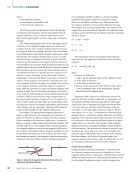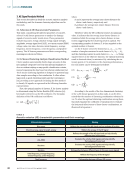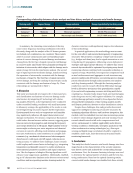is set to 4 mm. Magnetic leakage signals at 34°, 45°, and 63°
edge angles were detected using Hall sensors. The results are
shown in Figures 10a and 10b.
Figures 10a and 10b show that the radial signal fluctuates
on both the left and right sides of the peak. Additionally, the
signal peak increases and gradually moves away from the
center of the discontinuity as the edge angle increases. The
peak position of the axial signal shifts toward the side with the
larger edge angle, and the peak amplitude increases as the
edge angle of the discontinuity increases. These experimental
findings confirm the accuracy of the simulation results.
Conclusion
In this paper, the relationship between the edge angle of
V-shaped, trapezoidal, and other shaped discontinuities
and the variation of magnetic leakage signals is theoretically
analyzed, simulated, and experimentally verified. Based on the
in-depth analysis of the research results, the following conclu-
sions are drawn:
1. Whether the discontinuity is V-shaped, trapezoidal, or
inside-outside, both the axial and radial signal components
are influenced by the discontinuity’s edge angle. The specific
finding is as follows: as the edge angle increases, the peaks
of both axial and radial signals rise, and the gap between
the peaks of the radial signals widens. At the same time, the
peak position of the axial signal shifts in the direction of the
increasing edge angle.
2. A linear regression equation between the edge angle and
the position of the peak point of the radial signal is obtained
using the control variable method. This provides a basis for
studying the relationship between magnetic leakage signals
and discontinuity characteristics.
3. Combined with the relationship between the discontinuity
edge angle and magnetic leakage signal, in the future more
advanced algorithms, such as machine learning algorithms,
could be employed to analyze large datasets of magnetic
leakage signals from different discontinuities. This would
help construct a more accurate discontinuity reconstruc-
tion model, improve discontinuity detection accuracy, and
provide strong support for precise discontinuity assessment.
ACKNOWLEDGMENTS
This study was supported by the Science and Technology Program of
Anhui Province Market Supervision Administration in 2023 (2023MK041),
the Talent Introduction Program of Shanghai Institute of Electrical Engi-
neering (B1-0288-20-007-01-32), the project of Shanghai Multi-directional
Die-Forging Engineering and Technology Research Center (20DZ2253200),
and the Shanghai Highland Discipline Preliminary Research and Open
Program.
REFERENCES
Alaric, J. S., V. Suresh, A. Abudhahir, M. C. Sobia, and M. Baarkavi.
2018. “Theoretical Analysis of the Rectangular Defect Orientation using
Magnetic Flux Leakage.” Measurement Science Review 18 (1): 28–34.
https://doi.org/10.1515/msr-2018-0005.
Assylbekov, Y. M., and Y. Yang. 2015. “An inverse radiative transfer in
refractive media equipped with a magnetic field.” Journal of Geometric
Analysis 25 (4): 2148–84. https://doi.org/10.1007/s12220-014-9507-0.
Bao, S., M. Fu, Z. Zhao, and P. Jin. 2021. “Quantitative Stress Evaluation
and Defect Identification in Ferromagnetic Steels Based on Residual
Magnetic Field Measurements.” Materials Evaluation 79 (3): 311–19.
Bulgakov, A. A., and I. V. Fedorin. 2012. “The Phenomenon of Conical
Refraction in a Thin-Layer Periodic Semiconductor-Dielectric Structure
in a Magnetic Field.” Optics and Spectroscopy 112 (3): 474–81. https://doi.
org/10.1134/S0030400X12030071.
Dharmawan, I. D. M. O., J. Lee, and S. Sim. 2022. “Defect Shape Classi-
fication Using Transfer Learning in Deep Convolutional Neural Network
on Magneto-Optical Nondestructive Inspection.” Applied Sciences (Basel,
Switzerland) 12 (15): 7613. https://doi.org/10.3390/app12157613.
Domenech-Asensi, G., J. Hinojosa, J. Martinez-Alajarin, and J. Garrigos-
Guerrero. 2005. “Empirical Model Generation Techniques for Planar
Microwave Components Using Electromagnetic Linear Regression
Models.” IEEE Transactions on Microwave Theory and Techniques 53 (11):
3305–11. https://doi.org/10.1109/TMTT.2005.857331.
Feng, B., J. Wu, H. Tu, J. Tang, and Y. Kang. 2022. “A review of magnetic
flux leakage nondestructive testing.” Materials (Basel) 15 (20): 7362.
https://doi.org/10.3390/ma15207362.
Ganesh, R. S., P. Karuppasamy, A. Abudhahir, R. Vinoth, and S. Selvape-
rumal. 2020. “3D Modeling of MFL Imaging System to Detect Surface
Discontinuities in Ferromagnetic Tubes.” Materials Evaluation 78 (3):
379–386.
Han, W., X. Shen, J. Xu, P. Wang, G. Tian, and Z. Wu. 2014a. “Fast Estima-
tion of Defect Profiles from the Magnetic Flux Leakage Signal Based on a
Multi-Power Affine Projection Algorithm.” Sensors (Basel) 14 (9): 16454–66.
https://doi.org/10.3390/s140916454.
Han, W., J. Xu, P. Wang, and G. Tian. 2014b. “Defect Profile Estimation
from Magnetic Flux Leakage Signal via Efficient Managing Particle Swarm
Optimization.” Sensors (Basel) 14 (6): 10361–80. https://doi.org/10.3390/
s140610361.
Huang, S., L. Peng, H. Sun, and S. Li. 2023. “Deep Learning for Magnetic
Flux Leakage Detection and Evaluation of Oil &Gas Pipelines: A Review.”
Energies 16 (3): 1372. https://doi.org/10.3390/en16031372.
Kim, J. Y. 2012. “Bending of an electromagnetic wave in an ultra-strong
magnetic field.” Journal of Cosmology and Astroparticle Physics (10): 056.
https://doi.org/10.1088/1475-7516/2012/10/056.
Li, Y., J. Wilson, and G. Y. Tian. 2007. “Experiment and simulation study
of 3D magnetic field sensing for magnetic flux leakage defect character-
ization.” NDT &E International 40 (2): 179–84. https://doi.org/10.1016/j.
ndteint.2006.08.002.
Li, Z., R. Jarvis, B. P. Nagy, S. Dixon, and P. Cawley. 2017. “Experimental
and simulation methods to study the Magnetic Tomography Method
(MTM) for pipe defect detection.” NDT &E International 92 (1): 59–66.
https://doi.org/10.1016/j.ndteint.2017.07.018.
Long, Y., S. Huang, L. Peng, S. Wang, and W. Zhao. 2021. “A characteristic
approximation approach to defect opening profile recognition in magnetic
flux leakage detection.” IEEE Transactions on Instrumentation and
Measurement 70: 1–12. https://doi.org/10.1109/TIM.2021.3050185.
Mandache, C., and L. Clapham. 2003. “A model for magnetic flux leakage
signal predictions.” Journal of Physics. D, Applied Physics 36 (20): 2427–31.
https://doi.org/10.1088/0022-3727/36/20/001.
Meyer, R. M., I. Komura, K.-C. Kim, T. Zetterwall, S. E. Cumblidge, and
I. Prokofiev. 2016. “Overview of the program to assess the reliability of
emerging nondestructive techniques open testing and study of flaw type
effect on NDE response.” AIP Conference Proceedings 1706 (1): 200010.
https://doi.org/10.1063/1.4940654.
Norouzi, E., and H. Ravanbod. 2010. “Optimization of the Flux Distribution
in Magnetic Flux Leakage Testing.” Materials Evaluation 68 (3): 360–64.
M AY 2 0 2 5 • M AT E R I A L S E V A L U AT I O N 39
edge angles were detected using Hall sensors. The results are
shown in Figures 10a and 10b.
Figures 10a and 10b show that the radial signal fluctuates
on both the left and right sides of the peak. Additionally, the
signal peak increases and gradually moves away from the
center of the discontinuity as the edge angle increases. The
peak position of the axial signal shifts toward the side with the
larger edge angle, and the peak amplitude increases as the
edge angle of the discontinuity increases. These experimental
findings confirm the accuracy of the simulation results.
Conclusion
In this paper, the relationship between the edge angle of
V-shaped, trapezoidal, and other shaped discontinuities
and the variation of magnetic leakage signals is theoretically
analyzed, simulated, and experimentally verified. Based on the
in-depth analysis of the research results, the following conclu-
sions are drawn:
1. Whether the discontinuity is V-shaped, trapezoidal, or
inside-outside, both the axial and radial signal components
are influenced by the discontinuity’s edge angle. The specific
finding is as follows: as the edge angle increases, the peaks
of both axial and radial signals rise, and the gap between
the peaks of the radial signals widens. At the same time, the
peak position of the axial signal shifts in the direction of the
increasing edge angle.
2. A linear regression equation between the edge angle and
the position of the peak point of the radial signal is obtained
using the control variable method. This provides a basis for
studying the relationship between magnetic leakage signals
and discontinuity characteristics.
3. Combined with the relationship between the discontinuity
edge angle and magnetic leakage signal, in the future more
advanced algorithms, such as machine learning algorithms,
could be employed to analyze large datasets of magnetic
leakage signals from different discontinuities. This would
help construct a more accurate discontinuity reconstruc-
tion model, improve discontinuity detection accuracy, and
provide strong support for precise discontinuity assessment.
ACKNOWLEDGMENTS
This study was supported by the Science and Technology Program of
Anhui Province Market Supervision Administration in 2023 (2023MK041),
the Talent Introduction Program of Shanghai Institute of Electrical Engi-
neering (B1-0288-20-007-01-32), the project of Shanghai Multi-directional
Die-Forging Engineering and Technology Research Center (20DZ2253200),
and the Shanghai Highland Discipline Preliminary Research and Open
Program.
REFERENCES
Alaric, J. S., V. Suresh, A. Abudhahir, M. C. Sobia, and M. Baarkavi.
2018. “Theoretical Analysis of the Rectangular Defect Orientation using
Magnetic Flux Leakage.” Measurement Science Review 18 (1): 28–34.
https://doi.org/10.1515/msr-2018-0005.
Assylbekov, Y. M., and Y. Yang. 2015. “An inverse radiative transfer in
refractive media equipped with a magnetic field.” Journal of Geometric
Analysis 25 (4): 2148–84. https://doi.org/10.1007/s12220-014-9507-0.
Bao, S., M. Fu, Z. Zhao, and P. Jin. 2021. “Quantitative Stress Evaluation
and Defect Identification in Ferromagnetic Steels Based on Residual
Magnetic Field Measurements.” Materials Evaluation 79 (3): 311–19.
Bulgakov, A. A., and I. V. Fedorin. 2012. “The Phenomenon of Conical
Refraction in a Thin-Layer Periodic Semiconductor-Dielectric Structure
in a Magnetic Field.” Optics and Spectroscopy 112 (3): 474–81. https://doi.
org/10.1134/S0030400X12030071.
Dharmawan, I. D. M. O., J. Lee, and S. Sim. 2022. “Defect Shape Classi-
fication Using Transfer Learning in Deep Convolutional Neural Network
on Magneto-Optical Nondestructive Inspection.” Applied Sciences (Basel,
Switzerland) 12 (15): 7613. https://doi.org/10.3390/app12157613.
Domenech-Asensi, G., J. Hinojosa, J. Martinez-Alajarin, and J. Garrigos-
Guerrero. 2005. “Empirical Model Generation Techniques for Planar
Microwave Components Using Electromagnetic Linear Regression
Models.” IEEE Transactions on Microwave Theory and Techniques 53 (11):
3305–11. https://doi.org/10.1109/TMTT.2005.857331.
Feng, B., J. Wu, H. Tu, J. Tang, and Y. Kang. 2022. “A review of magnetic
flux leakage nondestructive testing.” Materials (Basel) 15 (20): 7362.
https://doi.org/10.3390/ma15207362.
Ganesh, R. S., P. Karuppasamy, A. Abudhahir, R. Vinoth, and S. Selvape-
rumal. 2020. “3D Modeling of MFL Imaging System to Detect Surface
Discontinuities in Ferromagnetic Tubes.” Materials Evaluation 78 (3):
379–386.
Han, W., X. Shen, J. Xu, P. Wang, G. Tian, and Z. Wu. 2014a. “Fast Estima-
tion of Defect Profiles from the Magnetic Flux Leakage Signal Based on a
Multi-Power Affine Projection Algorithm.” Sensors (Basel) 14 (9): 16454–66.
https://doi.org/10.3390/s140916454.
Han, W., J. Xu, P. Wang, and G. Tian. 2014b. “Defect Profile Estimation
from Magnetic Flux Leakage Signal via Efficient Managing Particle Swarm
Optimization.” Sensors (Basel) 14 (6): 10361–80. https://doi.org/10.3390/
s140610361.
Huang, S., L. Peng, H. Sun, and S. Li. 2023. “Deep Learning for Magnetic
Flux Leakage Detection and Evaluation of Oil &Gas Pipelines: A Review.”
Energies 16 (3): 1372. https://doi.org/10.3390/en16031372.
Kim, J. Y. 2012. “Bending of an electromagnetic wave in an ultra-strong
magnetic field.” Journal of Cosmology and Astroparticle Physics (10): 056.
https://doi.org/10.1088/1475-7516/2012/10/056.
Li, Y., J. Wilson, and G. Y. Tian. 2007. “Experiment and simulation study
of 3D magnetic field sensing for magnetic flux leakage defect character-
ization.” NDT &E International 40 (2): 179–84. https://doi.org/10.1016/j.
ndteint.2006.08.002.
Li, Z., R. Jarvis, B. P. Nagy, S. Dixon, and P. Cawley. 2017. “Experimental
and simulation methods to study the Magnetic Tomography Method
(MTM) for pipe defect detection.” NDT &E International 92 (1): 59–66.
https://doi.org/10.1016/j.ndteint.2017.07.018.
Long, Y., S. Huang, L. Peng, S. Wang, and W. Zhao. 2021. “A characteristic
approximation approach to defect opening profile recognition in magnetic
flux leakage detection.” IEEE Transactions on Instrumentation and
Measurement 70: 1–12. https://doi.org/10.1109/TIM.2021.3050185.
Mandache, C., and L. Clapham. 2003. “A model for magnetic flux leakage
signal predictions.” Journal of Physics. D, Applied Physics 36 (20): 2427–31.
https://doi.org/10.1088/0022-3727/36/20/001.
Meyer, R. M., I. Komura, K.-C. Kim, T. Zetterwall, S. E. Cumblidge, and
I. Prokofiev. 2016. “Overview of the program to assess the reliability of
emerging nondestructive techniques open testing and study of flaw type
effect on NDE response.” AIP Conference Proceedings 1706 (1): 200010.
https://doi.org/10.1063/1.4940654.
Norouzi, E., and H. Ravanbod. 2010. “Optimization of the Flux Distribution
in Magnetic Flux Leakage Testing.” Materials Evaluation 68 (3): 360–64.
M AY 2 0 2 5 • M AT E R I A L S E V A L U AT I O N 39













































































